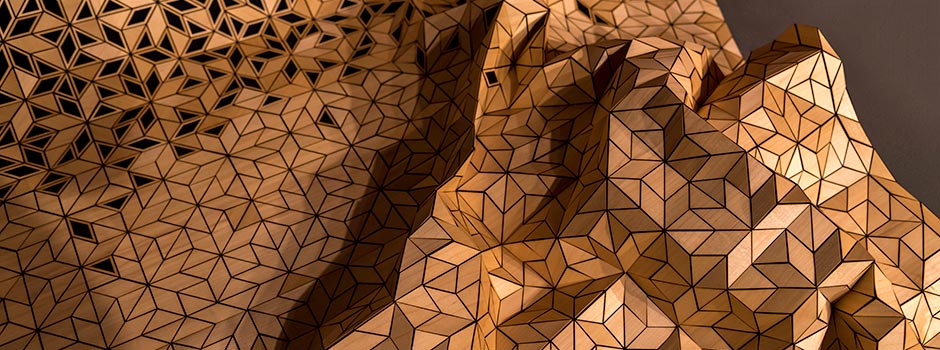
SHARJAH ISLAMIC ARTS FESTIVAL (SIAF) 2017/18 (DEC 13, 2017 - JAN 23, 2018) Wooden Textiles by Elisa Strozyk
Jan 10, 2018 Art Event

Under the patronage of His Highness Sheikh Dr Sultan Bin Mohammed Al Qasimi, member of the Supreme Council and ruler of Sharjah, the Cultural Affairs Department at the Sharjah Department of Culture has organised the 20th Edition of the Sharjah Islamic Arts Festival.
The installation 'Wooden Textiles', created by Elisa Strozyk is on view at the Sharjah Art Museum as part of the Sharjah Islamic Arts Festival 2017/18.
_IslamicArtsMagazine.jpg) Elisa Strozyk explains her installation to Sheikh Abdullah bin Salem Al Qasimi at the opening of the exhibition / Photo © Islamic Arts Magazine
Elisa Strozyk explains her installation to Sheikh Abdullah bin Salem Al Qasimi at the opening of the exhibition / Photo © Islamic Arts Magazine
The artist explains, that 'Wooden Textiles' convey a new tactile experience. "We are used to experience wood as a hard material; we know the feeling of walking across wooden floors, to touch a wooden tabletop or to feel the bark of a tree. But we usually don't experience a wooden surface which can be manipulated by touch. 'Wooden Textiles' is a material that is half wood-half textile, between hard and soft, challenging what can be expected from a material or category. It looks and smells familiar but feels strange, as it is able to move and form in unexpected ways."
To transform wood into a flexible surface the artist deconstructs wood into small triangular pieces, which are then attached to a textile base. Depending on the geometry and size of the tiles each design shows a different behaviour regarding flexibility and mobility. The 'Wooden Textiles' can be transformed in its shape and has a huge potential to be used in interior decorating as lamps, rugs, wall-pieces, curtains, etc. Each one as an extraordinary piece of art.
The installation 'Wooden Textile' comprises of three hanging large pieces. Each is in its own colour combination, ranging from the colour of the wood to red and black. The installation shows that the artist is clearly inspired by Islamic geometric patterns and that repeating the patterns symbolize infinity. Strozyk knows that Islamic aesthetic is not in copying the shapes and forms found in nature but conveying its meaning.
_IslamicArtsMagazine_01.jpg) Elisa Strozyk, 'Wooden Textiles', installation view / Photo © Islamic Arts Magazine
Elisa Strozyk, 'Wooden Textiles', installation view / Photo © Islamic Arts Magazine
_IslamicArtsMagazine_02.jpg) Elisa Strozyk, 'Wooden Textiles', detail / Photo © Islamic Arts Magazine
Elisa Strozyk, 'Wooden Textiles', detail / Photo © Islamic Arts Magazine
_IslamicArtsMagazine_03.jpg) Elisa Strozyk, 'Wooden Textiles', detail / Photo © Islamic Arts Magazine
Elisa Strozyk, 'Wooden Textiles', detail / Photo © Islamic Arts Magazine
_IslamicArtsMagazine_04.jpg) Elisa Strozyk, 'Wooden Textiles', detail / Photo © Islamic Arts Magazine
Elisa Strozyk, 'Wooden Textiles', detail / Photo © Islamic Arts Magazine
_IslamicArtsMagazine_05.jpg) Elisa Strozyk, 'Wooden Textiles', detail / Photo © Islamic Arts Magazine
Elisa Strozyk, 'Wooden Textiles', detail / Photo © Islamic Arts Magazine
_IslamicArtsMagazine_06.jpg) Elisa Strozyk, 'Wooden Textiles', installation view / Photo © Islamic Arts Magazine
Elisa Strozyk, 'Wooden Textiles', installation view / Photo © Islamic Arts Magazine
_IslamicArtsMagazine_07.jpg) Elisa Strozyk, 'Wooden Textiles', installation view / Photo © Islamic Arts Magazine
Elisa Strozyk, 'Wooden Textiles', installation view / Photo © Islamic Arts Magazine
Elisa Strozyk studied Textile and Surface Design at the KHB in Berlin and completed the MA course 'Future Textiles' in 2009 at Central Saint Martins in London. Her work is pushing the boundaries between 2D and 3D, hard and soft materials, switching meanings and categories. Elisa is building bridges between textile and furniture design, using wood to produce original textiles and objects. Besides this she is collaborating with different artists, designers and companies. For her experimental designs she received the German Design Award, given by the German Design Council and the German Ministry of Economics. Elisa‘s work is shown at 'Milan Furniture Fair', 'Design Miami', the Victoria & Albert Museum and Sharjah Art Museum, SIAF 2017/18.
Sharjah Islamic Arts Festival (SIAF) 2017/18 opened on December 13, 2017 and will run until January 23, 2018. Many exhibitions and large scale installations are on view at the Sharjah Art Museum, and on other venues such as Al Majaz Waterfront, Al Majaz Amphitheatre, Awqaf Department, Al Qasba, Maraya Art Centre, and Calligraphy Square.
Comments
Add a comment